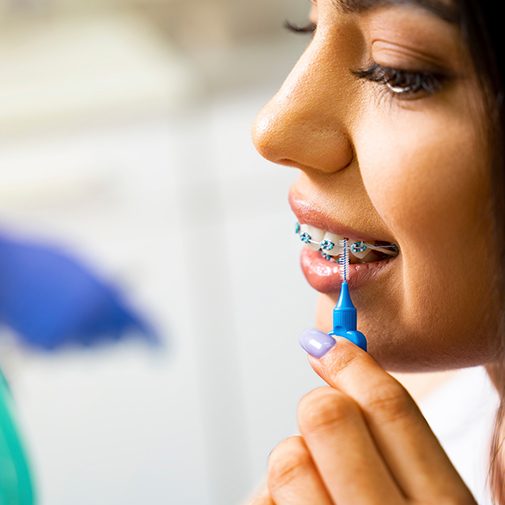Traditional Braces – Heath
A Time-Tested Way to Correct Misaligned Smiles

When it comes to straightening the teeth and fixing jaw-alignment problems, one of the most trusted and reliable treatments is traditional metal braces. They have been used for decades to correct a wide array of orthodontic issues for patients of all ages, and thanks to the latest advancements, they are now smaller, sleeker, and more effective than ever.
When you get braces in Heath, Mt. Vernon, or Columbus, we won’t just consider the alignment of your teeth when formulating your treatment plan. We’ll also take into account the function of your bite as well as the proportions of your face. That way, you won’t just achieve a straighter smile, but a result that’s spectacular for both your health and overall appearance as well. Give us a call to schedule a consultation with us today.
Why Choose Wigal Orthodontics for Traditional Braces?
- Two Esteemed Orthodontists with an Attention to Detail
- In-Network with Many Dental Insurance Companies
- We Use Cutting Edge Dental Technologies for Greater Efficiency
How Do Traditional Braces Work?

Traditional metal braces straighten the teeth using a system of metal brackets and wires. A bracket is applied to each tooth, and these are connected to a wire that runs along each row of teeth that will slowly guide them into the proper position over the course of treatment. This wire is held in place using a small elastic band on each bracket, and it will be regularly tightened every month. If a patient has a bite misalignment (such as an overbite, underbite, or crossbite), larger elastic bands can be attached to the brackets to help correct this problem as well.
The treatment time for braces can vary depending on each patient’s particular situation, but the average treatment time is usually about 1-2 years. In most cases, they will move the teeth in two phases. During the first, the crowns of the teeth (the portion that shows above the gums) will be shifted, and that will be followed by moving the roots. This will straighten crooked teeth, close gaps, and make sure a person can eat, speak, and smile with ease.
What Orthodontic Issues Can Braces Fix?

Traditional braces are one of the most popular options for correcting misaligned teeth due to all of the orthodontic problems they can successfully address. Here are the most common ones that we run into.
Bite Misalignment
If the jaws don’t come together as they should, you find issues like overbites, underbites, crossbites, and other issues. This can distract from your appearance and make it more challenging for you to speak, eat, and move the jaw. Traditional braces, sometimes paired with elastics, are able to guide the jaws into alignment.
Crowded & Crooked Teeth
When the teeth become crooked, overlapping, uneven, or crowded, they can trap plaque and bacteria, making it easier to develop oral health problems, like cavities, gum disease, and oral infections. Traditional braces can be used to realign the teeth to be the ideal distance apart.
Gapped Teeth
Many people are self-conscious of gaps between their teeth. These gaps also put the teeth and gums at higher risk of becoming damaged. Traditional braces can guide your teeth closer together to give you a more uniform smile.
Caring for Your Braces

When you have braces, it is essential that you take some extra steps to care for your smile. Here are some tips that we recommend helping your treatment go as smoothly as possible.
- Brush twice, floss, and rinse with mouthwash every day.
- Use a threaded flosser or water flosser to clean beneath the wires.
- Stay away from foods that are hard or sticky.
- Don’t chew on hard objects or use your teeth as tools.
- See us for periodic checkups so we can monitor your treatment.
Clear/Ceramic Braces

One of the biggest concerns with traditional braces is their noticeable appearance, and this causes many patients to avoid getting the orthodontic care they need. Fortunately, we can offer a much more cosmetically minded, subtle option with clear/ceramic braces. Rather than metal, the brackets are made of a clear ceramic, and the wires and elastics are transparent or tooth-colored as well. What you get is the same reliability as braces without the concern for your appearance. Clear braces are barely noticeable on the teeth, assuring you’ll be able to smile with confidence during your treatment.
Learn More About Clear/Ceramic Braces
Phase 1 Pediatric Orthodontics

Phase 1 Pediatric Orthodontic treatment can help a child who still has some of their baby teeth and none of their permanent teeth yet. It can be used to not only straighten the baby teeth, but also assist in the development of the jaw, correct its alignment, and even help the permanent teeth come in straight as well. With this, a child’s permanent teeth will require much less treatment in the future, which will help shorten their overall treatment time and improve their overall experience.
Learn More About Phase 1 Pediatric Orthodontics
Understanding the Cost of Traditional Braces

The cost of traditional braces varies from patient to patient, as there are a variety of factors that are considered, and every patient is different. During your consultation with us, we will go over the estimated cost of your treatment and payment options in detail, so you won’t run into any surprises. Until then, here are some things to take into account.
Factors That Affect the Cost of Traditional Braces

The cost of braces varies on multiple factors. Here are the most notable ones.
- Severity of Misalignment: The greater the distance that the teeth need to shift, the longer your treatment will take.
- Length of Treatment: In many cases, the longer you wear braces, the higher your treatment costs.
- Age: As an adult, your teeth are more firmly set in your jawbone than they were during childhood and adolescence. They take more time to move, so your treatment may cost slightly more.
- Number of Appointments: Throughout your treatment, braces need to be adjusted and tightened every two to eight weeks.
- Other Devices: Many patients with braces also need to wear other supplies, like space maintainers, palatal expanders, elastics, headgear, and retainers.
- Compliance with Treatment: For instance, if you have to wear rubber bands on your braces, but you don’t wear them enough, your teeth won’t move as expected, lengthening your treatment.
Professional Braces vs. “DIY” Braces: Which Costs More?

It can be tempting to try to save some money by opting for a “do-it-yourself” approach. There has been recent trend online of people trying to straighten their teeth using household items, like fishing line, earring backs, superglue, rubber bands, and more. These items may sound like they would do the job, but they are likely to cause some serious problems that will need to be addressed by an orthodontist anyway. This can spell disaster for your wallet!
Without the guidance of a dental professional, you should accidentally shift your teeth in the wrong direction, throw off your jaw alignment, and damage the soft tissues in your mouth. Ultimately, you could end up with some serious problems that need to be corrected. By seeing your dentist for traditional braces from the start, you can save your wallet!
Does Dental Insurance Cover Braces?

Some dental insurance plans include coverage for orthodontic treatment. It is more likely to be covered if you need them for an oral health issue, like a misaligned jaw or difficulty chewing. Additionally, some plans only cover braces for patients under the age of 18. If your insurance covers braces, you can typically expect up to 50% coverage. However, this can vary from plan to plan. You should check with your insurance provider ahead of time so that you know what you can expect.
Options for Making Braces Affordable

If you don’t have dental insurance, this doesn’t mean that you are completely out of luck. We are happy to accept payments through CareCredit – a third-party financing company that can split the cost of your treatment into manageable monthly installments with little to no interest. If you have any questions or need help applying, we would be happy to assist you!














